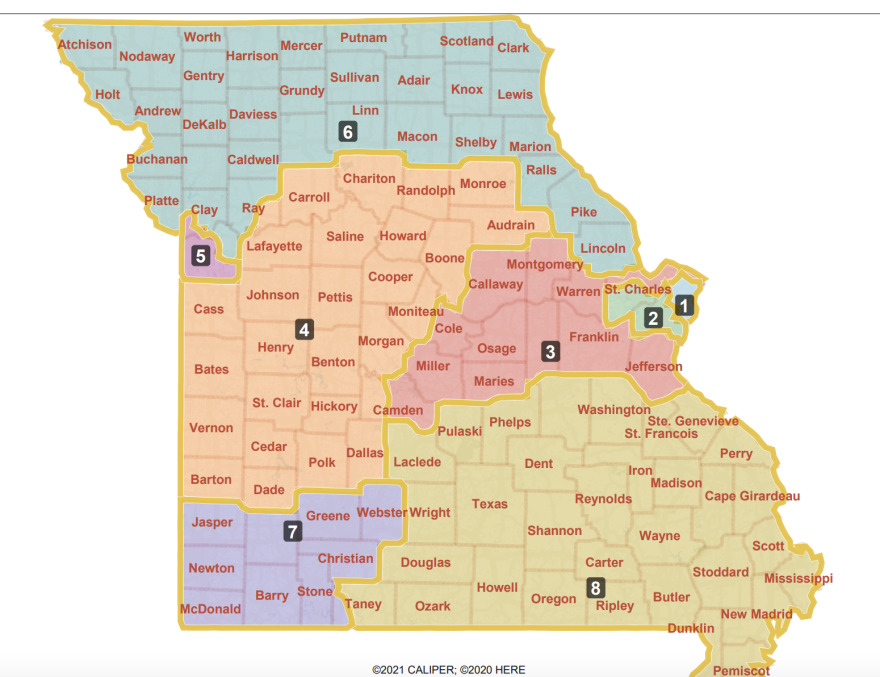Updated at 5 p.m. Dec. 30 with comments from legislators
The head of a House committee tasked with redrawing Missouri’s eight congressional districts presented a map that would make Rep. Ann Wagner’s district safer — while keeping a Kansas City-based district reliably Democratic.
If the General Assembly follows through with Rep. Dan Shaul’s plan, Missouri would be set up to send six Republicans and two Democrats to the U.S. House for the foreseeable future. That’s the same lineup currently in place.
“I think it’s the right thing to do,” Shaul said in an interview. “It was a map that I think accurately reflects the state of Missouri and the districts. We wanted to make sure the districts maintained their identity.”
Due to census delays and Gov. Mike Parson’s decision not to call a special session of the legislature, Missouri is undertaking congressional redistricting later than most states. Shaul, R-Imperial, has been conducting hearings over the past few months about how Missouri should proceed.
Shaul’s map would add more of St. Charles County to Wagner’s 2nd Congressional District. Some of Wagner’s more Democratic territory in St. Louis County would be placed in U.S. Rep. Cori Bush’s 1st District. That was widely expected, since Bush’s district needed to expand to make up for population loss. Jefferson County would now be completely within U.S. Rep. Blaine Luetkemeyer’s district.
Even though Wagner, R-Ballwin, won reelection last year by a fairly comfortable margin, the 2nd District was one of the closest in the nation in terms of how it voted for president. The proposed changes would make the 2nd District much more Republican.
Shaul’s map would keep U.S. Rep. Emanuel Cleaver’s Kansas City-based district solidly Democratic. It removes several rural counties that were historically favorable to Democrats but trended heavily toward the GOP after President Donald Trump’s election.
Many Missouri GOP officials who spoke to St. Louis Public Radio before the filing of Shaul’s map did not expect Cleaver’s district to change dramatically. They said transforming his district into solidly Republican turf would lead to short-term gains but long-term peril if suburbs in the 4th or 6th Districts became more Democratic throughout the decade.
“There’s no fixing this bill for 10 years,” Shaul said. “When myself and those who worked on the map looked at it, we looked at the long-term goal of giving continuity and consistency to the state of Missouri.”
But some Republicans wanted the legislature to go for what’s known as a “7 to 1” map as revenge for how Democrats hurt the GOP with redistricting in states like Illinois and Oregon. And it’s not out of the question that some Republican lawmakers could try to pursue that course when the legislative session starts Wednesday.
Shaul said he’s used to handling legislation that’s had some “rather vocal opposition.”
“I think it’s good to listen to other people's views,” Shaul said. “I’ve certainly listened to the 7 to 1 arguments. But at the end of the day, our purpose is to draw a map that truly reflects the population shifts and the population centers of the state of Missouri. And I think we have come to that conclusion with this map. And we’re always going to have people who say good and bad things about any bill. This is going to be no different."
A 7-to-1 map would face a lot of obstacles, as a number of Republicans in the House and Senate have publicly spoken out against such a move. And Senate Democrats have leverage to prevent that from happening, including threatening to use the filibuster to slow down the 2022 session.
Sen. Mike Bernskoetter, R-Jefferson City, who chairs the Senate committee on congressional redistricting, said in a statement that the proposed map “is a fair and constitutional map with common-sense boundaries that everyday Missourians can recognize.”
“This map, which must be passed by both the House and Senate, is also drawn to achieve the greatest amount of consensus possible,” Bernskoetter said. “My House counterpart and I chose to make this joint announcement to emphasize the great care that went into drawing a map we were confident could survive legislative, judicial, and public scrutiny.”
One concern for some lawmakers is what’s known as the emergency clause, which, if two-thirds of both chambers vote for it, would put the map into effect right away. If 12 Missouri senators decide to vote against the emergency clause, then the legislation containing the map won’t become effective until Aug. 28. And that could throw the Aug. 2 primary into chaos, since people can’t run in districts that don’t exist.
Shaul said he’s hopeful that the map will get bipartisan support and will pass with an emergency clause.
Filing begins for Missouri candidates on Feb. 22. But since a redistricting commission for state Senate districts deadlocked, it’s highly possible that lawmakers will have to move the filing period back. Shaul would like to pass the map “right before filing opens.”
Follow Jason on Twitter: @jrosenbaum








